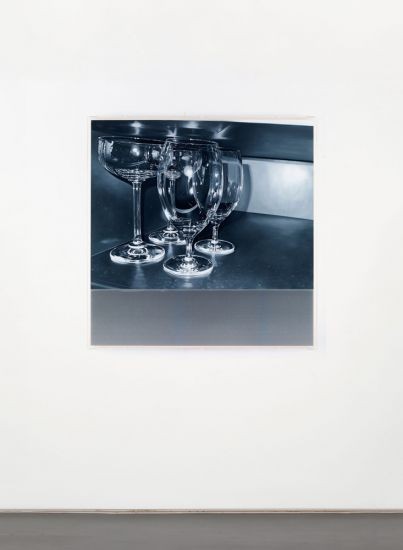James White
22 Jun - 11 Aug 2012
JAMES WHITE
Cornered
22 June – 11 August 2012
The six new paintings by James White, collectively titled ’Cornered’, indicate a development and departure for the artist. White paints with intense meticulousness to represent varying degrees of observation. He achieves an arresting description of material surface, with objects in corners, or at times pure shallow illusory space providing an almost claustrophobic, sense. The possibility of an extension of this space is also reflected, literally, in a strong understanding of the role of the photograph; the arbitrary cutting, cropping, and breaking of image, that became a constant feature for contemporary visual language. The unpainted strip of aluminium left at the base of each picture reflects the photographic image rendered more or less emphatic, continual, real, by the materiality of paint. Despite an apparent insistence on non-subject, on the notion of unspectacular occurrence, the paintings do also carry within them the promise of existential narrative.
White is thorough in his insistence of the way in which something can be painted without a touch of manner, or mannerism, without even the security of expression. Yet he has a style that is clear, however unromantic the subject and forcefully anti compositional the captured moment; still a narrative or echo seems to have gone before and will surely follow after. The silver balloon that has floated to the ceiling, for instance, might stay there forever. The water will break the dry study of the corner of the shower basin; the glass that shines with a sparkle that reflects the glass as much as the reflection, is also claustrophobically trapped by shelving that can both shelter and shatter if brought out at the wrong angle. The circular staircase with fine delicate banisters cuts into real space with a counter move, while the wooden stairs are painted with a sway of movement through. The painting of the corner of a room which seems such a muddle of musical instruments, cases and recording equipment, is a concentration of material that looks as if it needs to be unpicked.
Cornered
22 June – 11 August 2012
The six new paintings by James White, collectively titled ’Cornered’, indicate a development and departure for the artist. White paints with intense meticulousness to represent varying degrees of observation. He achieves an arresting description of material surface, with objects in corners, or at times pure shallow illusory space providing an almost claustrophobic, sense. The possibility of an extension of this space is also reflected, literally, in a strong understanding of the role of the photograph; the arbitrary cutting, cropping, and breaking of image, that became a constant feature for contemporary visual language. The unpainted strip of aluminium left at the base of each picture reflects the photographic image rendered more or less emphatic, continual, real, by the materiality of paint. Despite an apparent insistence on non-subject, on the notion of unspectacular occurrence, the paintings do also carry within them the promise of existential narrative.
White is thorough in his insistence of the way in which something can be painted without a touch of manner, or mannerism, without even the security of expression. Yet he has a style that is clear, however unromantic the subject and forcefully anti compositional the captured moment; still a narrative or echo seems to have gone before and will surely follow after. The silver balloon that has floated to the ceiling, for instance, might stay there forever. The water will break the dry study of the corner of the shower basin; the glass that shines with a sparkle that reflects the glass as much as the reflection, is also claustrophobically trapped by shelving that can both shelter and shatter if brought out at the wrong angle. The circular staircase with fine delicate banisters cuts into real space with a counter move, while the wooden stairs are painted with a sway of movement through. The painting of the corner of a room which seems such a muddle of musical instruments, cases and recording equipment, is a concentration of material that looks as if it needs to be unpicked.

